COTE VERMEILLE
DISCOVER THE VERMEIL COAST IN THE EASTERN PYRÉNÉES
The Côte Vermeille is an area of breathtaking beauty.
It corresponds to the Mediterranean coast of the Albères in the south of the Pyrénées-Orientales , from the beach of Racou, in Argelès-sur-Mer , to the Spanish town of Port-Bou, via Collioure.
The coastline attracts families, couples and groups of friends as much by the beauty of the beaches and small coves as by their proximity to the surrounding mountains, where people come to seek calm an freshness.
Where is the Côte Vermeille located?

The Côte Vermeille is an emblematic coastline of the Catalan territory, extending over no less than thirty kilometres.
It begins at the foot of the Albères, a mountainous barrier that dominates the coastline of Argelès-sur-Mer, among other places. It passes through several seaside destinations in the south: Collioure, then Port- Vendres, Banyuls-sur-Mer and Cerbère. The Côte Vermeille extends to the Spanish border at Port-Bou.
WHAT TO SEE ON THE VERMEILLE COAST?
Natural treasures and typical villages follow one another on the Côte Vermeille. Visitors also have the chance to discover a whole mosaic of landscapes, made up of heavenly beaches, small coves and vineyards.
Collioure
Located 25 km south of Perpignan, Collioure , the cradle of Fauvism in painting, is home to the Museum of Modern Art and numerous galleries. The village is considered the "jewel of the Côte Vermeille", as much for the beauty of its landscapes as for the richness of its historical and cultural heritage. Among its highlights, are the bell tower of the Notre-Dame-des-Anges church, a royal castle, the colourful houses of the Mouré district and the port.
Fort Saint-Elme
Situated half an hour from Collioure, the building offers a breathtaking view of the village, the sea, the mountains and the plain of Roussillon. Built in the 16th century by Charles V to protect the capital and lock the road to Barcelona, the fort was redesigned in the 17th century by the Marquis de Vauban, the military architect of Louis IV.
Cellier des Dominicains
This wine cooperative was founded in 1926 in a former church of the Dominican monastery, which dates from the 13th century and reached its peak in the middle of the 15th century during the reign of King James II of Majorca. Visitors flock here in particular to taste Banyuls, the sweet wine of the region.
Corniche road
From Collioure to Cerbère, beautiful landscapes are revealed on the Corniche road: creeks and beaches below, vineyards and mountains.
Port-Vendres
Port-Vendres is a typical Catalan destination. The town is a seaside resort, marina and fishing port. The Cité
de Vénus is one of Port-Vendres' must-sees. This is the road leading from the port to Cap Béar, leading to a strange red and white metal lighthouse. While the route can be physical, those who get up there will enjoy a breathtaking view covering the Côte Vermeille to Spain.
Paulilles site
Located 3 km from Port-Vendres, this listed site has natural treasures, including the beautiful beaches at Anse de Paulilles , between Cap Béar and Cap Oullestreil. It is also known for its industrial heritage, and visitors can learn the secrets of Catalan boat making at the foot of the Albères mountains.
Banyuls-sur-Mer
This seaside resort is the birthplace of Aristide Maillol, a painter, engraver and sculptor, known in particular for his synthetic vision, centred on the arrangement of masses and the radical break with the descriptive art of the 19th century. The port and the old neighborhood are among the points of interest of the city, which also offers many activities for families. It has given its name to a sweet wine that can be enjoyed in local restaurants and cellars with foie gras, cheese or dessert.
Sorède
Sorède is known above all for its ancestral manufacturing tradition of whips for equestrian use. The Vallée des Tortues, a zoological park dedicated to these animals, is a must see in the village, especially when travelling with children.
Cerbère
Last town before the Spanish border, between the sea and the mountains, Cerbère is a town where it is good to walk, on its pebble beach, its port or in its streets. To enjoy a beautiful panoramic view, you should go to the solar lighthouse of Cap Cerbère. From here you can admire Cap Creus and the Costa Brava. The town is also known for its 650-hectare marine nature reserve, where there are many diving centres.


























